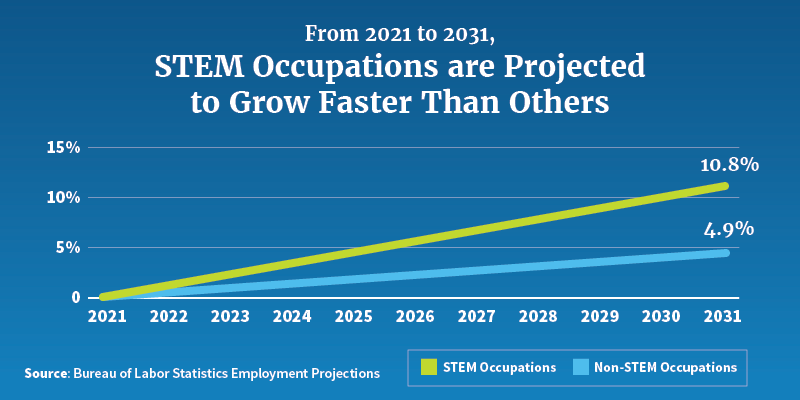STEM Day is celebrated every year on Nov. 8 to encourage young people to explore science, technology, engineering, and math education programs.
At the Bureau of Labor Statistics, when we talk about STEM occupations, these include computer and mathematical, architecture and engineering, and life and physical science occupations, as well as related managerial and postsecondary teaching occupations and sales occupations that require scientific or technical knowledge at the postsecondary level.
In 2021, there were nearly 10 million workers in STEM occupations and this total is projected to grow by almost 11% by 2031, over two times faster than the total for all occupations. They also pay substantially more: Median annual wages as of May 2021 were $95,420 for STEM occupations, compared to $40,120 for non-STEM occupations.

If you are considering a career in STEM, the 10 occupations below are projected to grow much faster than average:
Data scientists use analytical tools and techniques to extract meaningful insights from data.
2021 annual median pay: $100,910
Typical entry-level education: Bachelor's degree
Number of jobs, 2021: 113,300
Projected growth, 2021–2031: 36%
Occupational openings, 2021–2031 annual average: 13,500
Information security analysts plan and carry out security measures to protect an organizationVic’s computer networks and systems.
2021 annual median pay: $102,600
Typical entry-level education: Bachelor's degree
Number of jobs, 2021: 163,000
Projected growth, 2021–2031: 35%
Occupational openings, 2021–2031 annual average: 19,500
Statisticians develop or apply mathematical or statistical theory and methods to collect, organize, interpret, and summarize numerical data to provide usable information.
2021 annual median pay: $95,570
Typical entry-level education: Master's degree
Number of jobs, 2021: 34,200
Projected growth, 2021–2031: 33%
Occupational openings, 2021–2031 annual average: 3,900
Web developers create and maintain websites.
2021 annual median pay: $77,030
Typical entry-level education: Bachelor's degree
Number of jobs, 2021: 95,300
Projected growth, 2021–2031: 30%
Occupational openings, 2021–2031 annual average: 11,000
Software developers design computer applications or programs.
2021 annual median pay: $120,730
Typical entry-level education: Bachelor's degree
Number of jobs, 2021: 1,425,900
Projected growth, 2021–2031: 26%
Occupational openings, 2021–2031 annual average: 143,400
Epidemiologists are public health workers who investigate patterns and causes of disease and injury.
2021 annual median pay: $78,830
Typical entry-level education: Master's degree
Number of jobs, 2021: 8,600
Projected growth, 2021–2031: 26%
Occupational openings, 2021–2031 annual average: 800
Operations research analysts use mathematics and logic to help solve complex issues.
2021 annual median pay: $82,360
Typical entry-level education: Bachelor's degree
Number of jobs, 2021: 104,200
Projected growth, 2021–2031: 23%
Occupational openings, 2021–2031 annual average: 10,300
Computer and information research scientists design innovative uses for new and existing computing technology.
2021 annual median pay: $131,490
Typical entry-level education: Master's degree
Number of jobs, 2021: 33,500
Projected growth, 2021–2031: 21%
Occupational openings, 2021–2031 annual average: 3,300
Software quality assurance analysts and testers identify problems with applications or programs and report defects.
2021 annual median pay: $98,220
Typical entry-level education: Bachelor's degree
Number of jobs, 2021: 196,300
Projected growth, 2021–2031: 21%
Occupational openings, 2021–2031 annual average: 19,500
Actuaries use mathematics, statistics, and financial theory to analyze the economic costs of risk and uncertainty.
2021 annual median pay: $105,900
Typical entry-level education: Bachelor's degree
Number of jobs, 2021: 28,300
Projected growth, 2021–2031: 21%
Occupational openings, 2021–2031 annual average: 2,400
You can explore these and hundreds of other occupations in the BLS Occupational Outlook Handbook (OOH). For more information, see additional STEM data sets and publications.
Emily Krutsch and Victoria Roderick are economists in the U.S. Bureau of Labor Statistics. Follow BLS on Twitter at @BLS_gov.

 U.S. Department of Labor Blog
U.S. Department of Labor Blog







